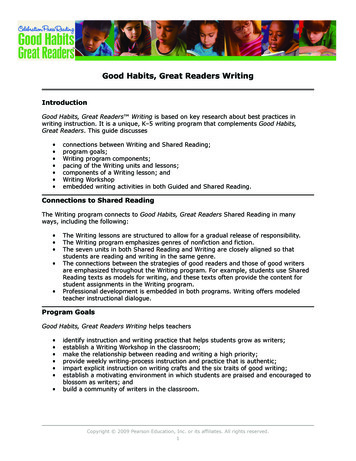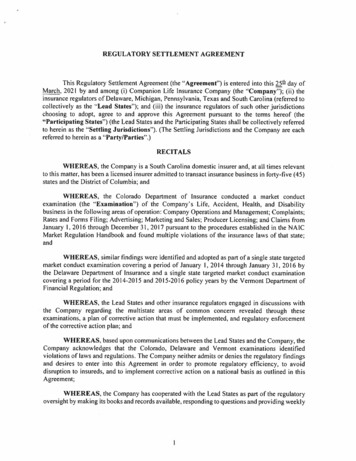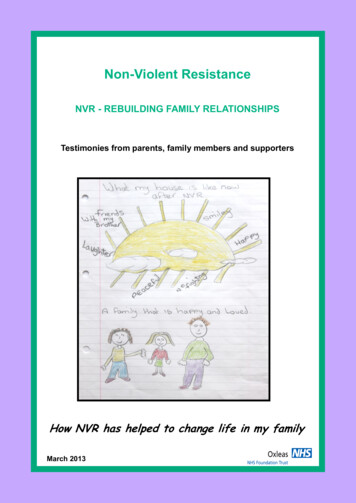
Transcription
ForewordPeople who use health and social care services,should have services that they have been part ofchoosing, that meet their needs, and are based onthe best research and standards.Care plans are the way we plan and agree howsomeone’s health and social needs can be met,and how good health and wellbeing can besupported.They are the most important document that professionals, service usersand their families share, and are the means of communicating anapproach, a service, or a treatment between all those involved.We believe that this process is so important that it needs proper supportand training to help people develop skills and experience in working inpartnership to agree a plan.Carolyn GreenExecutive Director of Nursing and Patient ExperienceDerbyshire Healthcare NHS Foundation TrustThis guide has been put together by the CareCoordination Association and DerbyshireHealthcare NHS Foundation Trust in partnership(based on the Trust’s award-winning booklet), andis intended to support good practice in careplanning.It includes a summary of current policy, standards,guidance and recommendations at the time ofwriting, together with guidelines and suggestionsabout how to write a good care plan. We also look at how someone canplan their own care, and manage their wellbeing.It is the first of a series looking at best practice in the care process.Jaswinder BasiChairCare Coordination Association1
Contents1. What is care planning?2. Care Planning Standards3. Person-centred planning4. Managing your own care plan5. Whose care plan is it anyway?6. What’s in a care plan?7. Safety planning8. Involving carers and families9. Writing good care plans10. Involvement11. Accessibility and communication12. Choice and capacity13. Professional approach to care planning14. Coordination of care plans15. Types of care plan16. References, legislation, policiesTerminology: The terms ‘service user’ or ‘person’ are used throughout thedocument to indicate people who use health and social care services, inline with national policy and guidance.Disclaimer: This handbook is guidance only, does not constitute legaladvice, and should not be regarded as definitive. Every effort has beenmade to ensure the accuracy of this guidance; however neither the CareCoordination Association nor Derbyshire Healthcare NHS FoundationTrust accept any liability for its accuracy and for any decisions that may bebased on it. Individuals and agencies must always check against currentlegislation, guidelines and local policies.2
1. What is Care Planning?This booklet is for anyone who wants to understand how to plan care, andwould like to develop skills in care planning. This includes people who usehealth and social care services and their families and carers, those whowork in health and social services, and those who work in partnerorganisations.To help write better care plans, it’s important first to understand what careplans are, and what is involved in making a care plan.A care plan is.A plan that describes in an easy, accessible way the needs of theperson, their views, preferences and choices, the resourcesavailable, and actions by members of the care team, (including theservice user and carer) to meet those needs. It should be puttogether and agreed with the person through the process of careplanning and review.Care planning involves. Gathering and sharingstories: the views of allconcerned, including theperson’s, family and carers,and professionalsEstablishing clear mutualexpectations with serviceusers and carersA systematic review of theneeds of the personExploring and discussing choices: to help work out what’s mostimportant, and the implications of different choicesGoal setting: what do we want to achieve and by when?Action planning: what are we going to do, who is responsible, andwhen will it be reviewed?Safety: how do we make care as safe as possible?Support: for someone to manage their own health as much aspossible3
A care plan is. The written record of a plan of actionnegotiated with the person to meettheir health and social needsSomething which sets out who isdoing what, when, and why (outlinesaims, actions and responsibilities)A tool to support the safety of theservice user and othersA plan which can be used and understood in a crisis by service users,their families and carers and other agencies, as well as colleaguesA plan which people feel they ownBased on a thorough assessment of needProduced in partnership with all those concernedCoordinated by the most appropriate person, such as a CareCoordinator or lead professionalProduced in the most appropriate forumShared effectively with those who are part of itPart of a process that supports care planning under systems such asthe Care Programme Approach, Care and Treatment Planning(Wales), Long Term Conditions Planning, Health Action Planning etc.and meets professional, local and national standards.A care plan is not a. Bureaucratic exercise, but is anessential element in engagingservice users and communicatingwhat the service can and will do,and what responsibilities they,family and carers, and the personconcerned will haveWish list, but is a plan of agreedelements of careContract (although it may formpart of a contract in somecircumstances), but is acommitment to a course of actionfrom all those involved.4
What does a good care plan look like to me as theowner of the plan?“The care plan is not just about problems, it’s a way of managingthings you want or need to change in your life.” (service user)“When I was in mental health care, I had a particularly goodnurse. She was very good because she didn t force herself onme, she was friendly, kept things light and helped me developpractical plans when I wasn t so well.” (patient survey comments)What does a good care plan look like to me as a familymember?“I have found that being included in the whole support packagehas made things work more smoothly. I can now contact theworkers involved when early warning signs are being displayed,and with prompt intervention sometimes prevent hospitaladmission.” Please Remember Ben5
How are we doing nationally?“In response to every question asked in the survey aboutinvolvement only 50% to 60% were completely positive aboutbeing involved in their own care. This means that only: 56% of people responding were ‘definitely’ involved as much asthey wanted to be in agreeing what care they received 61% ‘definitely’ felt that decisions were made together by themand the person they saw.”CQC Community Mental Health Survey 2015Why is personalised care so important and how is itdemonstrated in care planning?“As a Director of Nursing in an NHS Trust, I want to see that theclinical staff I employ are really starting to change their clinicalpractice, I would like to be able to open a person’s case record toget a real sense of the person in receipt of our services. What theywant, how they feel, their treatment goals in the sense of symptomrecovery, their health goals and their social recovery.Until we have care plans that reflect the person, their goals andthe clinical staff member’s role in enabling the person to meet theirgoals and achievements, however large and small, we are failingto provide the type of contemporary health service I want myfamily to receive.We will achieve this, but we all need to embrace the shift in power,from the first contact, in enabling decisions to break the cycle ofindividuals and families being passive recipients of care.”Carolyn Green6
2. Care Planning StandardsStandards for care planning come from a number of sources, but thenational CCA standard is:“A Care Plan is a written record of the agreed care andtreatment plan for an individual”(Care Standards Handbook CCA 2014)National Standards for care plans include: The Care Quality Commission’s (CQC) ‘Essential Standards ofQuality and Safety’, Outcome 4: Care and welfare of people whouse services: People should get safe and appropriate care thatmeets their needs and supports their rights.CQC Fundamental standards include: care and treatment must beappropriate and reflect service users' needs and preferences.NICE Quality Standard for service user experience in adultmental health People using mental health services jointly develop acare plan with mental health and social care professionals, and aregiven a copy with an agreed date to review it.Mental Health Act 1983 Code of PracticeDepartment of Health (2007) Best Practice in Managing RiskDepartment of Health (2008) Refocusing the Care ProgrammeApproachProfessional standardsNational and Local Recording standardsYour local or national care planning standard is .7
3. Person-centred planning“Trust and honesty should underpin the engagementprocess to allow for an equitable partnership betweenservices users, carers and providers of services.”Department of Health 2008 Refocusing the CPAPerson-centred planning should be at the heart of professional practice.Identifying needs and preferences and helping people to articulate theseinvolve: Values including: respect; honesty; and dignity Listening and communication skills Assessment skills in a wide variety of areas Understanding issues of capacity and consent The right tools, resources or skills to support the person.You might ask someone: What is important to you?What do you hope to do, and what prevents you?What works well, and who supports you?What do you want to change?How would you like your support to work?What would you like to do next?The CCA standard for service user involvement and choice is:“People who use services will be treated with respectas partners in planning care, and their recovery andwellbeing supported” (Care Standards Handbook CCA 2014)The fundamental standards from the CQC include:Person-centred care: Treatment that is tailored to the service userand meets their needs and preferences.Guidance: Providers must do everything reasonably practicable tomake sure that people who use the service receive person-centredcare and treatment that is appropriate, meets their needs and reflectstheir personal preferences, whatever they might be.8
4. Managing your own care planThere are many ways in which people can manage their own health, orparts of it, and this can be an important opportunity to help someone feelin control of what’s happening, and to enhance their wellbeing.Planning to improve your wellbeing could focus on the 5 Ways toWellbeing:Connect - Be active - Be mindful - Keep learning - Give to othersThe idea of recovery and wellbeing supports this.Recovery approaches help people to manage theirown health through tools such as WRAP (WellnessRecovery Action Planning), which help you to identifywhen you’re not feeling well, and help you work outthe best way to manage it.Think of a health issue you would like to managebetter, or use an example from someone you know:My PlanHealth issue:What makes it better?What makes it worse?Who or what can help:What I plan to do:9
5. Whose care plan is it anyway?“The approach to individuals’ care and support puts them at thecentre and promotes social inclusion and recovery. It is respectful –building confidence in individuals with an understanding of theirstrengths, goals and aspirations as well as their needs and difficulties.It recognises the individual as a person first and patient/service usersecond.” Department of Health Refocusing the CPA 2008How a care plan is put together can have a major impact on how much theplan is owned by the person whose plan it is, and hence how effective thecare plan is.A care plan that is written by one person alone in an office may include allthe key elements, but is not likely to be as effective in practice as onewhich is written in partnership with the person and others who are part ofthe plan.A sense of ownership by all those concerned (and in particular the personthemselves) is vital in making the plan translate into reality. This can beimproved by: Using people’s own words and phrases (familiar and comfortablelanguage, which avoids jargon and abbreviations)Using goals, aims and outcomes identified by the personRecognising that care plans exist for the benefit of the serviceuser, and should be based around the needs of that person, not onthe services availableUnderstanding that people with long term conditions may be atdifferent stages on their journey, which may affect how muchcontrol they are able to takeEnsuring the person feels that they own the plan, throughdeveloping, agreeing and writing the care plan as much as possible,including the opportunity to review the plan to ensure it isunderstandable, and to have a copy as soon as possibleProducing the plan in a format and style that the person iscomfortable with, and can useBeing flexible in the approach to the involvement of those who havea stake in the plan.10
6. What’s in a care plan?Care plans should include (write in the missing words): Why are we doing this? (a ) What are we planning to achieve? (o ) How are we going to do it? (a ) Who will do it? (r ) Where will it be done? (l ) When will it be done by? (t )See suggested answers on p.38The care plan should also: Focus on people’sstrengths and wishes Include the person’s rolein the plan Reflect the individualscultural and ethnicbackground as well astheir gender, sexuality,race, economic disadvantage, age, religion/spirituality, and disability Consider the role of any family or carers who are involved Include action and outcomes in all relevant aspects of an individual’slife Consider any safeguarding issues for children or vulnerable adults Consider safety issues Include crisis and contingency arrangements Give the date of the next planned review Cover transfer details if appropriate Identify any unmet needs Acknowledge areas of difference or disagreement.11
7. Safety planningSafety planning and riskmanagement are anessential part of careplanning, and should bewoven into the care plan.This should be based on asound assessment of safetyissues and risks to theperson, their family andothers. Safety plans should: Be formulated collaboratively with the service user and their carer(s)Avoid professional jargon and use language the service userunderstands; use their own words where possibleBe clearly and effectively communicated to all concerned.Person-centred safety planningPerson-centred safety planning is a fundamental process within a careplan. The Care Programme Approach process involves identifying specificactions based on an individual’s needs, taking into account safety and riskissues. All the needs of the individual should be reflected in a care plan,including all those relating to risk.“Best Practice in Managing Risk” (Department of Health, 2007) describesbest practice in safety planning. The guidance identifies positive riskmanagement, a collaborative approach building on strengths/resourcesand the roles of services and individuals as key to an effective safetymanagement plan. Safety plans should incorporate actions which supportthe individual’s needs and priorities alongside minimising risks to theindividual or others.The language used is important. For the person to retain ownership avoidthe use of professional jargon. The term “risk management” can potentiallycreate an obstacle to working together. Discussions about staying safeand how the organisation or individual can support with this can be moreconstructive and collaborative (Morgan, 2013).12
Crisis and contingency plansCrisis and contingency plans must be based on the individualcircumstances of the person, however, where there are no risks identified,contact information may be sufficient. This should always include 24 houra day 7 day a week contact details.Crisis plans should set out the action to be taken if the service userbecomes very ill, or their health is deteriorating rapidly. The plan shouldinclude: Who the service user responds best to and how to contact themPrevious strategies that have been successful in similar situationsEarly warning signs and specific relapse indicatorsThe responsibilities of all members of the care team. This shouldinclude the service user; the family (with their agreement) and thecommunity.Good practice example:When Jay stops making eye contact and starts pacing, make surethat he has a quiet place to go where other people will not disturbhim, ring his Mum on 243657 (who can usually reassure and calmhim) and if further advice is needed contact his GP.Contingency plans should help to prevent a crisis developing when, atshort notice, the coordinator is not available, or part of the care plancannot be provided. The person’s health may be affected by the problem,but is not the cause of it. The plan must include: Information about who to contact if the coordinator is not availableA contingency for any key elements of the care planWrite a good practice example of a contingency plan forsomeone whose carer is frail and in poor health:13
In practice it may be useful to think about: Can this plan help make the person feel that thestranger at the end of the phone knows about them, andunderstands what will help?Which elements of the care plan are essential, including thoseelements without which the person’s wellbeing or safety would beseriously compromised?Making sure that those included in the plan understand and accepttheir roleCrisis plans for people with more complex needs, such as those whoneed the CPA, or have complex long term conditions, should be morethan just a list of telephone numbersCrisis plans will often be referred to when the person is experiencingdistress, and events may be fast-moving, so plans need to be clearThey should reflect the person’s views and wishesPlans should be written with the person and their carer(s) whereverpossibleBy being explicit and instructional the plan is more beneficial to theperson, their carer(s) and other service staffPeople with mental health problems are at greater risk than thegeneral population of developing physical health problems, with thosediagnosed with a serious mental illness dying up to 20 years earlierthan the general population from preventable diseases which affectthe population, such as cardiovascular and respiratory disease.Write a good practice example of a safety plan for Annie, anelderly woman with dementia who is regularly walking aboutoutside at night.Aim:Person’s view:Actions:14
8. Involving carers and familiesCarers and families can play a vitalpart in keeping their relative or friendwell.In working with carers and families it isimportant to be clear about the viewsof the person being supported abouttheir involvement, and what informationcan and should be shared.Involvement in care planning can take many forms, and can be anythingfrom getting copies of letters about appointments to full involvement inplanning and reviewing care.The Triangle of Care: Carers included (2010) has six key standards thatoutline the approach that mental health services should take:1) Carers and the essential role they play are identified at first contactor as soon as possible thereafter.2) Staff are ‘carer aware’ and trained in carer engagement strategies.3) Policy and practice protocols re: confidentiality and sharinginformation, are in place.4) Defined post(s) responsible for carers are in place.5) A carer introduction to the service and staff is available, with arelevant range of information across the care pathway.6) A range of carer support services is available.The CCA standard for working with families and carers is:“Families and Carers are partners in supporting the ServiceUser, they should be involved in planning care, and havetheir own needs recognised.”(Care Standards Handbook CCA 2014)Carers Support PlansAll informal carers who provide regular support for someone are entitled toan assessment of their caring, physical and mental health needs, and asupport plan to meet the needs identified.15
This may include (depending on the needs identified): Information, including where and how to access services, both duringoffice hours and in a crisisAction to meet defined contingenciesWhat will be provided to meet the carers identified mental andphysical health needsAdvice on income, housing, educational and employment mattersArrangements for short term breaks and respiteArrangements for social support, including access to carers supportgroupsInformation about appeals or complaints procedures.In practice it may be useful to think about: Other agencies may be commissioned to provide the assessment andsupport plan - find out who they areThe carers support plan may (with everyone’s agreement) be part of ajoint one with the service userWhere no needs are identified, or the carer refuses an assessment,contact information for the carer may meet the requirements of thesupport planThe carers support plan should be reviewed at least annuallyThe Care Act 2014 affects carers rights and services. Find out thesituation in your area.Write an example of a support plan for a carer who needsto be able to take up a leisure activity:Aim:16
9. Writing good care plansIt is important to give some thought to the contentand style of the care plan, as well as the process ofputting it together.We often use statements such as ‘monitor health’or ‘monitor medication’ with no indication aboutwhat precise aspects of someone’s health shouldbe monitored, or how these should be monitored.As a minimum, the care planning discussion shouldinclude: agreeing the person’s own goals (e.g. I want to lose weight, stopsmoking, get out more, get a job, manage the voices better) providing information that is timely, relevant, and accessible supporting individuals to take an active role in their own health agreeing any actions or treatments, and who is responsible for them agreeing a timely review dateIn practice, it may be useful to write The care plan as ‘I need’, to encourage the service userto own the care planClear outcomes that are person-centredInterventions that relate directly to the needs and goalsActions that include the person’s own responsibilitiesStatements of action that are instructional and able to be followed inyour absenceCare plans in partnership with the person whose plan it is, in languagethey are comfortable with.Remember: people should have a copy of their own care plan.How could you write ‘monitor mental health’ better?17
The SMART approach to care plansSMART is a well-known acronym for Specific, Measureable,Attainable/Achievable, Relevant/Realistic and Time-bound/Timely/Timelimited. It has been used to support systematic planning in many areasincluding health, business, and education. It can help you to develop plansthat are clear, can be implemented, and can be evaluated.Specific: This stresses the need for a specific goal rather than a moregeneral one. This means the goal is clear and unambiguous; withoutvagaries and platitudes.Measurable: This stresses the need for concrete criteria for measuringprogress. The thought behind this is that if a goal is not measurable it isnot possible to know whether the service user and the team are makingprogress toward successful completion. Measuring progress is supposedto help us stay on track, and experience the positive experience ofachievement.Attainable/Achievable: This stresses the importance of goals that arerealistic and also attainable. Whilst an attainable goal may stretch a teamin order to achieve it, the goal is not extreme. That is, the goals are neitherout of reach. When you identify goals that are most important to theservice user you begin to work out ways you can make them come true.You develop the attitudes, abilities, skills and resources to reach them.Relevant/Realistic: This stresses the importance of choosing goals thatmatter. A bank manager's goal to "Make 50 peanut butter sandwiches by2pm" may be specific, measurable, attainable and time-bound but lacksrelevance. Relevant goals support the service user to move forward. Agoal that supports or is in alignment with other goals would be considereda relevant goal. A relevant goal can answer yes to these questions: Does this seem worthwhile? Does this match our other efforts/needs? Is this the right time? Is it being supported by the right person?Time-bound: This stresses the importance of grounding goals within arealistic time-frame. A commitment to a time-frame helps a team focustheir efforts on completion of the goal on or before the due date. A timebound goal will usually answer the question When? What can I do six months/six weeks from now? What can I do today?18
Is the following care plan SMART? What areas are missing orunclear?Care Plan date:CommentsAim: to improve John’s current situationActions:1. To help John get back to workOT2. Refer John to X for help with angermanagementCPN3. Monitor medicationCPN4. Check benefitsSW5. To review the plan in six months CPNIdentifying needs:Care plans should always identify needs (rather thanservices), so the following is an inadequate care plan:NeedActionResponsibleHome helpEvery dayHome helpInstead of: Need Home help or even Need Have a fire lit and help withmorning routines, the need should represent what the action is reallyintended to meet. No-one has a need for a Home Help, the need is foradequate warmth, or cleanliness, or personal care.The action to meet the need might be: to have a home help who undertakes certain tasks, or support for the person to learn to do this, or to consider a change of heat source, depending on what theperson feels would best support their independence.19
Good practice example:NeedActionResponsibleKeep warm and getup in the morningHome help every morningbetween 9 and 10 a.m. tolight the fire and help withpersonal careJo Smith,Social WorkerAccuracy and completenessThe care plan should always be able to be picked up and used bycolleagues if the person coordinating the care is not there, so must includeenough information for someone else to implement the plan.NeedActionResponsibleDay HospitalEvery Thursday forReminiscenceManagerWrite a better care plan:Goal or outcome:NeedActionResponsibleUnmet needs“Named care coordinators should record any needs the person hasthat health and social care practitioners cannot meet. Discuss andagree a plan of action to address these needs with the person andtheir carer.” NICE 2015 Older people with social care needs andmultiple long-term conditionsIt is important that any needs that are identified as part of assessment orreview are included in the care plan. If they can’t be met, this should bediscussed, and the plan should include actions working towards meetingthem.20
10. InvolvementInvolvement of the person in their own care is essential, but not alwaysachieved. Many policy documents and good practice initiatives have theexpectation that people are very actively involved in the decisions abouttheir care and treatment. The diagram below aims to help us recogniseand understand the different levels of involvement and in turn to recogniseways to promote and encourage that active involvement.The model is portrayed as a seesaw, representing the balance of powerwithin the service user/professional relationship. At the lower end, the levelof participation and collaboration is quite low, with much of the ‘power’appearing to reside with the professional. Even at this level there is anassumed level of participation relating to informing and consulting with thepatient/service user. As you move up the spectrum, and they are involvedmore collaboratively in planning their care, the balance starts to shift moreequally, then in the persons favour as they move more towards selfdirected care. (Ann Munro)What factors may make people fall to the bottom of theinvolvement balance?21
Managing your own healthInvolvement includes empowering, informing, supporting and encouragingsomeone to take control of their own health as much as possible. Patientswith high levels of involvement and ‘activation’ understand their role in thecare process and feel capable of fulfilling that role.The Patient Activation Measure (PAM) measures an individual'sknowledge, skill, and confidence for self-management, allowing the rightkind of support to be offered for the level of activation (levels one to four).Research shows that appropriately designed interventions can increasepeoples’ levels of activation, with associated health benefits. The 13question scale asks for one of four levels of agreement and covers: Knowledge (e.g. I understand the nature and causes of my healthcondition); Beliefs (e.g. When all is said and done, I am the person who isresponsible for managing my health condition); Confidence in interacting with healthcare professionals (e.g. I amconfident I can tell my health care provider concerns I have evenwhen he or she does not ask); and Self-efficacy (e.g. I am confident that I can maintain lifestyle changeslike diet and exercise even during times of stress).Think about how someone you know would answer these similar questionsin relation to care planning. They may need to take it one step at a time,but they are indicators that the person is working towards being fullyinvolved and managing their own health:KnowledgeI understand what my health condition is and how it can be managedI have choice in the treatments and support in my care planBeliefsI feel that I own my care plan, and that it accurately reflects my views,opinions and choicesI am happy with the way that my family/carers are involvedConfidence in interacting with healthcare professionalsI can talk to my health and social care professionals about my planI know what to do if I have any side effects from medicationSelf-efficacyI have my own plan to manage periods of stress anddifficulty and am confident I can use it when I need to22
How well is the plan working
would like to develop skills in care planning. This includes people who use health and social care services and their families and carers, those who work in health and social services, and those who work in partner organisations. To help write better










